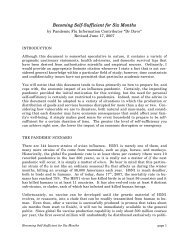You also want an ePaper? Increase the reach of your titles
YUMPU automatically turns print PDFs into web optimized ePapers that Google loves.
THE SIX BASIC SCOUT KNOTS AND HITCHES<br />
THE REEF KNOT A flat and easily untied knot.<br />
How to tie it: Say to yourself, "Right over left and<br />
under. Left over right and under." Then take a<br />
piece of rope or thick string and practise.<br />
SHEEPSHANK<br />
Not really a knot. Tied in the bight of a rope for shortening a rope or<br />
taking up the slack or to pass the strain over a weakened or frayed<br />
part of the rope.<br />
As the bowline is a<br />
knot that makes a<br />
loop that does not<br />
slip, it is used for<br />
rescues and lifelines<br />
BOWLINE<br />
This is the king of knots. The most useful and one of the simplest<br />
ways of putting a fixed loop into a rope. The basic purpose is to<br />
put a nonslip knot into a rope, and thus form an eye or loop or<br />
bight. It is easy to tie and untie and it never slips or jams. The<br />
bowline has a large number of variations but the one shown is<br />
the basic jack-of-all-trades<br />
CLOVE HITCH<br />
The clove hitch is easy to tie in a number of different ways<br />
and is also easy to untie. It is possibly the nearest there is<br />
to a general utility hitch. Care must be taken not to use it<br />
when a rolling hitch would serve better. It is used to start<br />
and end lashings.<br />
ROUND TURN-AND-TWO HALF HITCHES<br />
This is a very secure hitch in almost all<br />
circumstances. It is a good haulage hitch, or for<br />
securing guy lines. Also useful for tying up a boat or<br />
an animal to a pole as it can stand a lot of strain.<br />
Make sure you can tie the Clove Hitch and Round<br />
Turn-and-Two Half Hitches quickly and securely as<br />
you will need these to start and finish lashings, which<br />
form a large part of Scout Pioneering Projects.<br />
SHEETBEND<br />
This knot, like most bends, is used for<br />
tying two ropes together. Note that to be<br />
correct the two ends should be on the<br />
same side of the knot. If the two ropes<br />
differ in thickness a double sheetbend<br />
should be used. All this is to take an<br />
extra turn around the thicker rope<br />
before finishing
















